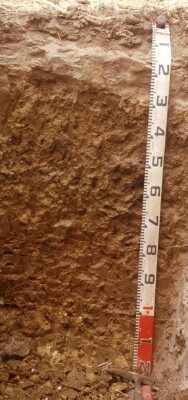SFS22
Location: Rocklea (West of Shelford)
Aust. Soil Class.: Vertic (& Calcic), Mottled-Mesonatric, SODOSOL
General Landscape Description: Paddock north of shearing shed
Site Description: Simple slope (1½%) with southerly aspect
Landform: Undulating plain
Geology: Neogene sediments (Moorabool Viaduct)
Element: Simple slope
Slope: 1.5%
Aspect: South
Soil Profile Morphology:
| Surface Soil |  SFS 22 | ||
| Ap | 0-10 cm | Dark brown (10YR3/3 moist) to light yellowish brown (10YR6/4 dry); loamy sand; apedal structure; loose with some weak fragments. pH 6.0; abrupt change to: | |
| A2(e) | 10-20/35 cm | Dark yellowish brown (10YR 4/4 moist) to pale brown (10YR6/3 dry) or light yellowish brown (10YR6/4 moist) conspicuously bleached (10YR7/3 dry); variable thickness and more bleached where closer to A2/B21 boundary; sandy loam; few coarse buckshot/ferruginous gravel in thicker zones of A2; apedal structure; firm (dry); pH 5.7; sharp, smooth and wavy change to: | |
| Subsoil | |||
| B21t | 20/35-65 cm | Brown (10YR4/3) ped faces with yellowish brown (10YR 5/6) matrix with red (10-20%) (10R 4/6) mottles common; medium clay; coarse (40-80 mm) prismatic (some peds tending to have domed tops), parting to coarse (20 mm) angular blocky, polyhedral and even lenticular peds. pH 7.2; gradual or diffuse change to: | |
| B22t | 65-95 cm | Dark yellowish brown (10YR4/6) matrix and strong brown (5YR 4/6) ped surfaces; medium clay; angular blocky and lenticular peds (30 – 60 mm); many vertic features. pH 8.7; clear change to: | |
| B23ss | 95-120+ cm | Strong brown (7.5YR5/8) matrix with yellowish red (5YR 4/6) ped surfaces/infill; light clay; soft yellow (10YR7/6) calcium carbonate, visible effervescence with dilute acid; pH 9.3. | |
 Subsoil peds |  Material from B23k or C/B horizon (1 metre) |
Key Profile Features:
- Strong texture contrast between surface (A) horizons and subsoil (B21) horizon.
- Lateral variation in soil profile due to gilgai microrelief (e.g. variations in depth of subsurface A2 horizon; variation in amount of ironstone gravel).
Soil Profile Characteristics:
pH | Salinity Rating | |||
Surface (A1 horizon) | Moderately Acid | Low | Non-Sodic | |
Subsoil (B21 horizon) | Near Neutral | Low | Strongly Sodic | |
Deeper subsoil (at 95-120 cm) | Very Strongly Alkaline | Medium | Strongly Sodic |
Horizon | Horizon Depth (cm) | pH (water) | pH (CaCl2) | EC dS/m | NaCl | Exchangeable Cations | |||
Ca | Mg | K | Na | ||||||
meq/100g | |||||||||
Ap | 0-10 | 6.0 | 5.6 | 0.21 | 6.1 | 1.2 | 0.50 | 0.41 | |
A2 | 10-35 | 5.7 | 5.3 | 0.14 | 1.1 | 0.46 | <0.05 | 0.19 | |
B21 | 35-65 | 7.2 | 6.4 | 0.31 | 0.03 | 4.9 | 7.8 | 0.4 | 4.2 |
B22 | 65-95 | 8.7 | 7.9 | 0.54 | 0.06 | 4.6 | 10 | 0.4 | 5.7 |
B23 | 95-120 | 9.3 | 8.6 | 0.69 | 0.07 | 4.7 | 9.9 | 0.4 | 5.6 |
Horizon | Horizon Depth (cm) | Exchangeable Aluminium mg/kg | Exchangeable Acidity meq/100g | Field Capacity pF2.5 | Wilting Point pF4.2 | Coarse Sand (0.2-2.0 mm) | Fine Sand (0.02-0.2 mm) | Silt (0.002-0.02 mm) | Clay (<0.002 mm) |
Ap | 0-10 | <10 | 6.3 | 14.8 | 8.7 | 14.4 | 62.7 | 8.0 | 7.5 |
A2 | 10-35 | <10 | 1.7 | 10.8 | 2.0 | 16.4 | 68.4 | 8.5 | 5.0 |
B21 | 35-65 | 35.5 | 23.4 | 5.1 | 23.1 | 4.0 | 65.0 | ||
B22 | 65-95 | 39.1 | 20.1 | 6.2 | 35.3 | 4.5 | 51.0 | ||
B23 | 95-120 |
Management Considerations:
Whole Profile
- Plant available water capacity (PAWC) is considered to be very low (estimated at 33 mm) in the upper 30 cm of this soil profile. Effective rooting depth (ERD) is restricted to 30 cm due to the highly sodic subsoils.
- The texture contrast and the sodic (ESP is around 25%) subsoil restricts drainage and the soils readily become waterlogged in winter.
- The sandy topsoil is very susceptible to soil structure decline; the weak aggregation is readily destroyed by cultivation and the soils are prone to compaction. Bare soil is vulnerable to structural breakdown by rain (slaking and sealing) and to erosion by water. In dry conditions these soils are known to be vulnerable to wind erosion.
- Plough pans are common in these soils. Disruption of pans by tillage is short lived unless controlled traffic is deployed in cropping situations. Raised beds have been used with some degree of success in these soils but the unstable topsoils do not lend themselves well to bed survival.
- Other parts of the paddock were reported as having a high gravel or buckshot content though little was found in this pit.
- See also SFS19 for related soil. Principle difference between this and SFS19 is the presence of calcareous material at 1 metre and the higher sodicity (SFS19 is only marginally sodic).
- At this pit site very little iron rich gravel was found but it is known that more substantial patches of gravel exist in this paddock (landholder information).
- Profile described by Richard MacEwan, May 1999.


